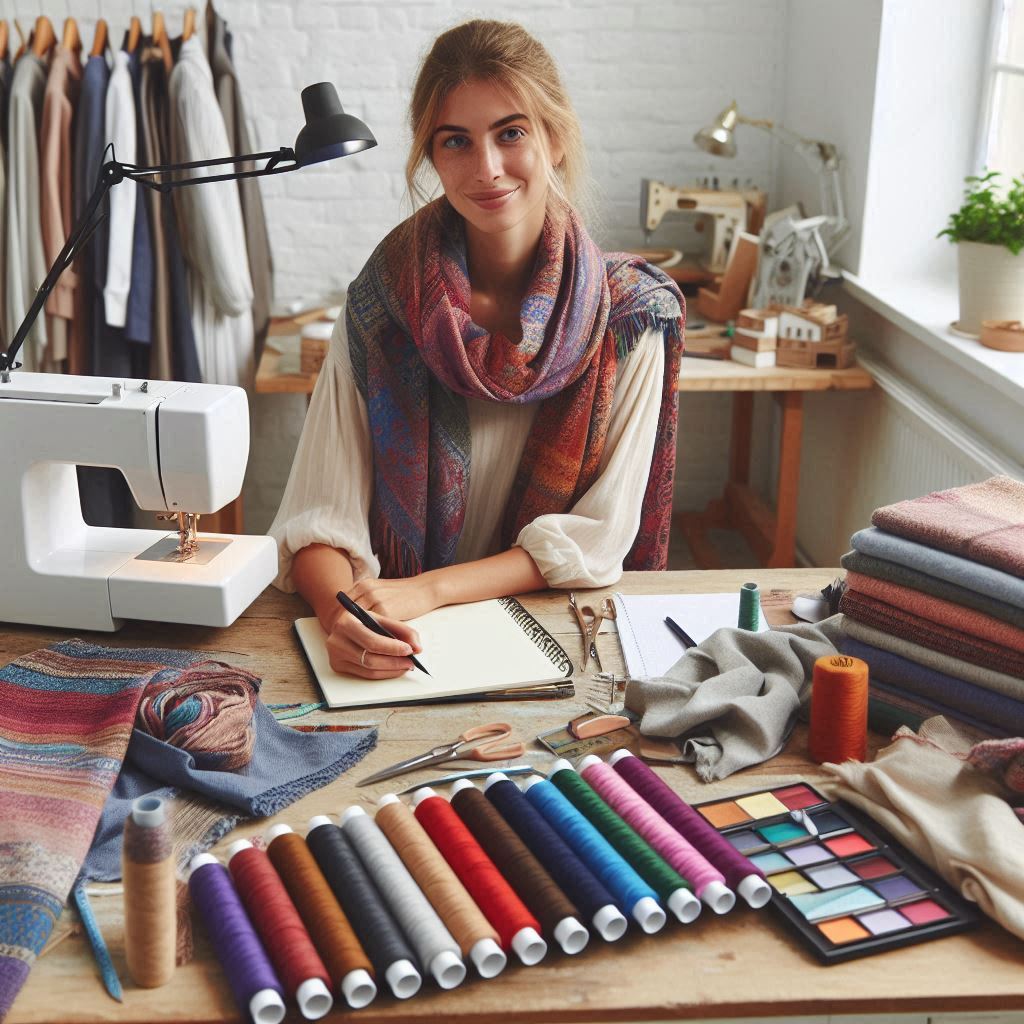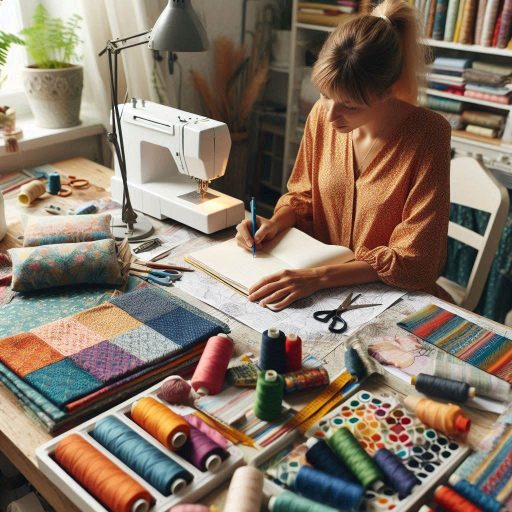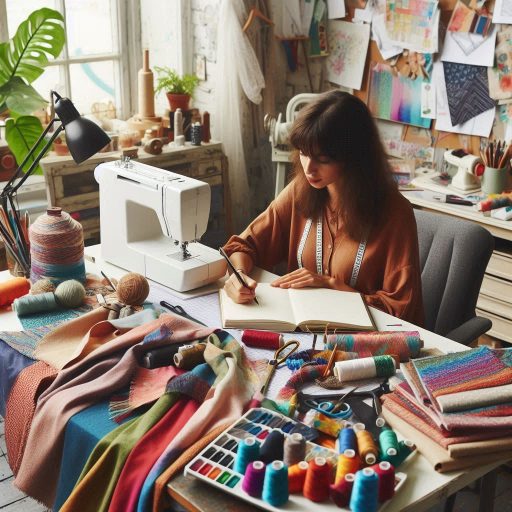Introduction
Textile design techniques play a crucial role in the fashion and interior industries, influencing both aesthetics and functionality.
These techniques allow designers to create fabrics that not only look beautiful but also serve practical purposes.
By mastering a variety of methods, designers can express their creativity and explore new ideas, leading to innovative and unique textiles that stand out in the marketplace.
Different textile design techniques, such as weaving, printing, and dyeing, each offer distinct possibilities.
Weaving involves interlacing threads to create texture and intricate patterns, providing depth to the fabric.
This technique can produce everything from simple stripes to complex geometric designs, allowing for endless customization.
On the other hand, printing enables designers to apply vibrant colors and detailed motifs onto fabric surfaces, making textiles visually striking and dynamic.
Dyeing techniques allow designers to achieve a wide range of hues and effects, enhancing the visual appeal of fabrics.
Methods like tie-dye and batik create unique, one-of-a-kind patterns, while more advanced techniques can yield gradient effects or rich, saturated colors.
Combining these diverse techniques leads to innovative designs that capture consumer interest and push creative boundaries.
Embracing a variety of textile design techniques fosters creativity and encourages experimentation.
History of Textile Design Techniques
Textile design techniques have a rich history, deeply rooted in human creativity and culture.
Understanding their origins provides insight into how these techniques have evolved.
Origins of Textile Design Techniques
- Ancient Civilizations: Textile design began thousands of years ago.
Early civilizations like the Egyptians and Mesopotamians used simple weaving methods.
They created intricate patterns using natural dyes from plants and minerals. - Indigenous Cultures: Indigenous cultures worldwide developed unique textile techniques.
For example, Native Americans used beadwork and weaving to create stunning textiles.
Similarly, South American cultures employed vibrant colors and patterns, often inspired by nature.
How techniques have evolved over time
Textile design techniques have continually evolved due to technological advancements and cultural exchanges.
- The Industrial Revolution: The Industrial Revolution marked a turning point.
New machinery, such as the power loom, increased production speed.
This allowed designers to create more complex patterns at lower costs. - Global Influences: Trade routes facilitated the exchange of ideas and techniques.
The introduction of Indian block printing and Chinese silk influenced European textile designs.
Designers began to blend different cultural elements, enriching their creations. - Modern Innovations: In the 20th century, designers experimented with synthetic fibers.
These innovations expanded the possibilities for color, texture, and pattern.
Digital printing emerged as a groundbreaking technique, allowing for intricate designs and faster production.
Key moments in history that have influenced textile design techniques
Several pivotal moments have shaped the landscape of textile design:
- The Jacquard Loom (1804): Joseph Marie Jacquard invented the Jacquard loom.
This machine revolutionized weaving by using punched cards to control patterns.
It enabled intricate designs and laid the foundation for future automation in textiles. - The Arts and Crafts Movement (1880s): This movement emphasized traditional craftsmanship and quality.
Designers like William Morris revived historical techniques and inspired a return to handcrafted textiles.
Their focus on aesthetics influenced future textile designs. - Post-World War II Era: After World War II, textile design reflected cultural shifts.
Designers embraced bold colors and abstract patterns, influenced by modern art movements.
This period marked the rise of iconic textile designers like Verner Panton and Alexander Girard.
Textile design techniques have a vibrant history shaped by various cultures and innovations.
From ancient weaving to modern digital printing, each era contributed to the rich tapestry of textile design.
Understanding this evolution helps designers appreciate the techniques and inspires future creativity.
As we explore new technologies, we honor the past while paving the way for future innovations in textile design.
Read: Famous Costume Designers in Hollywood
Traditional Techniques
Overview of traditional textile design techniques such as weaving, knitting, and embroidery
Traditional textile design techniques have stood the test of time.
Techniques such as weaving, knitting, and embroidery form the backbone of textile creation.
Each method has unique characteristics and cultural significance.
Weaving
Weaving is one of the oldest textile techniques.
It involves interlacing threads to create fabric.
Weaving can produce a variety of textures and patterns.
Traditional looms, like the handloom, enable artisans to weave intricate designs.
Today, modern weaving still uses these age-old methods alongside advanced technology.
Knitting
Knitting is another traditional technique that involves interlocking loops of yarn.
This method allows for flexibility and warmth in fabrics.
Knitting originated centuries ago, evolving from simple techniques to complex patterns.
Contemporary designers often blend traditional knitting with innovative materials.
This combination results in unique, modern designs that still honor their roots.
Embroidery
Embroidery adds decorative elements to fabrics using needle and thread.
This technique has existed across cultures, each with distinct styles.
Traditional embroidery techniques, like cross-stitch and satin stitch, remain popular today.
Many artisans incorporate these techniques into contemporary pieces, creating vibrant, textured designs.
Explanation of how these techniques are still used today
Despite the rise of modern manufacturing, traditional techniques continue to thrive.
Many designers recognize the value of handmade craftsmanship.
They integrate traditional methods into their work, ensuring these skills are preserved.
For instance, artisans often create limited-edition pieces that showcase intricate handwork.
These pieces often stand out in a market flooded with mass-produced items.
Modern textile design increasingly emphasizes sustainability.
Many designers return to traditional techniques as a response to fast fashion.
Handwoven fabrics, knitted garments, and embroidered details add uniqueness and quality.
Consumers appreciate the story behind each piece, further driving demand for traditional craftsmanship.
Examples of traditional techniques in modern textile design
Several designers highlight traditional techniques in their collections.
For example, renowned fashion houses often collaborate with local artisans.
They combine contemporary designs with traditional methods, showcasing the beauty of heritage craftsmanship.
This collaboration not only supports artisans but also educates consumers about textile history.
Art exhibitions also focus on traditional techniques.
Many showcase the evolution of textile design, emphasizing its cultural significance.
These exhibitions often include workshops, allowing visitors to experience traditional techniques firsthand.
Traditional textile design techniques remain relevant in today’s fashion landscape.
Weaving, knitting, and embroidery offer rich histories and artistic expression.
Modern designers continue to draw inspiration from these methods, ensuring their survival.
By embracing traditional techniques, the textile industry celebrates heritage while innovating for the future.
Read: Building a Portfolio for Costume Design
Contemporary Techniques
Introduction to modern textile design techniques such as digital printing, laser cutting, and heat transfer
In today’s rapidly evolving world of textile design, modern techniques play a crucial role in pushing the boundaries of creativity and innovation.
Designers are increasingly leveraging advanced methods to transform traditional textiles into extraordinary pieces that capture attention and evoke emotion.
Techniques like digital printing, laser cutting, and heat transfer lead this revolution. They empower designers to unleash their imagination.
These methods help produce stunning creations that reflect contemporary trends and individual expression.
Explanation of how these techniques have revolutionized the industry
Digital printing has dramatically transformed the way patterns and designs are created.
Digital printing offers intricate details and vibrant colors. It prints directly onto fabrics with precision.
Unlike traditional screen printing, it avoids limitations on colors and complexity.
Laser cutting provides an unprecedented level of precision and intricacy, enabling designers to achieve complex patterns and shapes that were once deemed impossible.
This technology allows for clean, precise edges and detailed cutouts, enhancing the visual appeal of textiles.
Designers can create intricate lace-like patterns or geometric shapes, adding depth and texture to their pieces.
The speed and accuracy of laser cutting also streamline production processes, making it easier to bring bold ideas to life.
Heat transfer is another groundbreaking technique that has revolutionized textile design.
This method enables designs to be transferred onto fabrics quickly and efficiently, significantly reducing production time and costs.
It offers the flexibility to apply a wide range of materials, including vinyl and sublimation prints, onto various substrates.
Designers create eye-catching graphics and personalized designs effortlessly.
This technique proves popular for fashion apparel and promotional items.
Transform Your Career Today
Unlock a personalized career strategy that drives real results. Get tailored advice and a roadmap designed just for you.
Start NowExamples of contemporary techniques in popular brands and collections
Leading brands like Chanel, Gucci, and Alexander McQueen embrace contemporary techniques in their collections.
They showcase the endless possibilities of digital printing, laser cutting, and heat transfer.
Chanel’s recent collections showcase bold, graphic prints made possible by digital technology.
These innovations push the boundaries of print application on high-fashion garments.
Gucci often incorporates laser-cut detailing in their accessories, creating striking visual elements that elevate their designs.
Alexander McQueen has famously utilized heat transfer techniques to create unique fabric effects that blend artistry with functionality.
Their runway shows showcase intricate designs that use modern techniques.
These techniques create groundbreaking aesthetics that challenge traditional textile design notions.
Contemporary textile design techniques have truly revolutionized the industry, pushing the boundaries of creativity and innovation to new heights.
As technology continues to advance, the potential for exploration and experimentation within textile design expands exponentially.
The fusion of artistry and technology opens up exciting possibilities for designers, allowing them to create textiles that resonate with consumers on a deeper level.
As we look to the future, we can only imagine the groundbreaking advancements that await in the world of textile design, paving the way for a new era of fashion and artistry.
Read: Networking Events for Costume Designers

Sustainable Techniques
Discussion of sustainable textile design techniques such as natural dyeing, zero-waste pattern cutting, and upcycling
Natural Dyeing
Natural dyeing is a traditional technique that involves using plant-based materials, minerals, and other organic substances to color textiles.
This method stands in stark contrast to synthetic dyes, which are often derived from petroleum and can be harmful to both the environment and human health.
Natural dyes, on the other hand, are non-toxic and biodegradable, making them a sustainable choice for textile production.
Zero-Waste Pattern Cutting
Zero-waste pattern cutting is an innovative design approach that maximizes the use of fabric during the garment creation process.
By carefully planning patterns to utilize fabric efficiently, designers can significantly reduce the amount of textile waste generated during production.
This method minimizes the leftover scraps that typically end up in landfills, addressing a critical issue in the fashion industry.
Upcycling
Upcycling is the transformative process of repurposing discarded or unused materials into new products of higher quality or value.
In the context of fashion, this means taking old textiles, garments, or even waste materials and creatively reinventing them.
Upcycling not only breathes new life into what might be considered trash but also reduces the demand for new raw materials, thus supporting a more circular economy.
Explanation of how these techniques promote environmental and ethical practices
Sustainable textile design techniques like natural dyeing, zero-waste pattern cutting, and upcycling provide significant environmental and ethical benefits.
Implementing these methods reduces waste and pollution.
They promote resource conservation and support ethical production practices.
By choosing these techniques, designers can create a positive impact on the industry.
These practices minimize the negative impacts of textile production on the planet.
They significantly reduce waste generation and support fair labor practices in the supply chain.
By prioritizing sustainability, designers and brands can contribute to a healthier planet while also addressing social issues related to labor rights and ethical sourcing.
The adoption of these techniques encourages a more responsible fashion industry, one that values both the environment and the people who work within it.
Case studies of designers and brands implementing sustainable techniques
- Stella McCartney: A renowned designer celebrated for her unwavering commitment to sustainability.
McCartney employs innovative techniques, including zero-waste pattern cutting, to minimize her environmental impact.
Her collections exemplify how high fashion can coexist with ethical practices, inspiring others to follow suit. - Patagonia: An outdoor apparel brand recognized as a leader in sustainable fashion.
Patagonia implements natural dyeing processes and embraces upcycling to create eco-friendly products.
Their commitment to transparency and environmental responsibility sets a benchmark in the industry, encouraging other brands to adopt similar practices.
By highlighting these case studies, designers and brands demonstrate that sustainable techniques in textile design are feasible and beneficial.
They serve as role models for others in the industry.
Their success stories inspire others in the fashion industry to embrace sustainability, contributing to a more ethical and environmentally friendly future.
Read: Historic Costume Design Inspirations
Experimental Techniques
Exploration of experimental textile design techniques like fabric manipulation, 3D printing, and smart textiles
Fabric manipulation
Fabric manipulation is a technique that involves creating unique textures and shapes by manipulating fabric through techniques like folding, pleating, and twisting.
This process adds dimension and visual interest to the fabric.
3D printing
3D printing has revolutionized textiles.
Designers can now create intricate and complex structures.
These designs were once impossible with traditional methods.
This technique opens up a world of possibilities for creating innovative and futuristic designs.
Smart textiles
Smart textiles, also known as e-textiles, incorporate electronics and technology into fabric, allowing for interactive and responsive garments.
These textiles can monitor biometric data, change color, or even generate electricity through movement.
They represent the fusion of fashion and technology.
Analysis of how these techniques push boundaries and challenge traditional concepts of textiles
Experimental textile design techniques push boundaries by challenging the conventional notions of what textiles can be.
They encourage designers to think outside the box and push the limits of creativity.
Through fabric manipulation, designers can create avant-garde designs that defy traditional fabric structure, resulting in visually striking and unconventional garments.
This technique allows for endless possibilities for creative expression.
3D printing revolutionizes the way textiles are created, allowing for the production of unique and complex patterns that were previously unattainable.
This technique pushes the boundaries of textile design by combining technology with traditional craftsmanship.
Smart textiles blur the line between fashion and technology, showcasing the potential for fabrics to be more than just functional.
By integrating sensors and electronics into garments, designers can create interactive and innovative clothing that responds to the wearer’s movements and environment.
Showcase of innovative designs that have been created using experimental techniques
Designers around the world have embraced experimental techniques to create groundbreaking designs that defy traditional norms.
These innovative creations showcase the limitless possibilities that can be achieved through experimentation.
From intricately pleated fabrics to intricately printed patterns, designers are pushing the boundaries of textile design to create truly unique and innovative pieces.
These designs challenge the status quo and redefine what is possible in the world of textiles.
By incorporating smart textiles into their collections, designers are able to create garments that not only look visually stunning but also serve a functional purpose.
These interactive and technologically advanced garments blur the line between fashion and technology, creating a new realm of possibilities for the future of textiles.
Experimental textile design techniques have revolutionized the field of textiles by pushing boundaries, challenging traditional concepts, and inspiring innovation.
By embracing these techniques, designers can create truly unique and groundbreaking designs that captivate and inspire.
Cultural Influence on Textile Design Techniques
Textile design reflects the rich tapestry of cultures worldwide.
Each culture contributes unique techniques that enhance global textile practices.
This section explores how various cultures have shaped textile design and the significance of traditional methods.
How different cultures around the world have influenced textile design techniques
Asian cultures showcase diverse textile techniques. For example:
- Japanese Shibori: This tie-dye technique creates intricate patterns through precise folding and binding.
- Indian Block Printing: Artisans use carved wooden blocks to imprint vibrant designs on fabric, a practice that dates back centuries.
- Chinese Silk Weaving: This ancient technique produces luxurious fabrics, highlighting craftsmanship and intricate designs.
These methods not only reflect aesthetics but also convey cultural narratives and history.
Highlighting of traditional techniques from various regions and their significance in the global textile industry
African textiles exhibit bold colors and patterns, often carrying symbolic meanings.
Key techniques include:
- Kente Weaving: Originating from Ghana, Kente cloth features vibrant colors and geometric designs that represent social status and history.
- Adire Dyeing: This Nigerian technique uses resist dyeing to create intricate patterns, often telling stories or reflecting beliefs.
- Mud Cloth (Bògòlanfini): Mali’s traditional mud cloth features natural dyes and symbols, serving both decorative and ceremonial purposes.
These techniques demonstrate the deep connections between textiles and cultural identity.
Showcase Your Business Today
Reach thousands of readers actively exploring professional services. Publish your business profile and grow your audience now.
Publish NowEuropean Contributions
European textile design techniques emphasize artistry and innovation.
Notable examples include:
- Tapestry Weaving: Popular in medieval Europe, tapestry weaving combines art and storytelling, often depicting historical events or mythology.
- Lace Making: This delicate art form originated in Italy and France, showcasing intricate patterns that adorn garments and home decor.
- Jacquard Weaving: Developed in France, this technique uses punched cards to create complex patterns, revolutionizing textile manufacturing.
These contributions highlight the blend of functionality and artistry in European textiles.
How cross-cultural exchanges have enriched textile design practices
Cross-cultural exchanges significantly enrich textile design practices.
The interaction of different cultures leads to:
- Innovation: New techniques emerge when artisans share knowledge and materials.
- Fusion: Blending traditional methods creates unique textile designs that reflect diverse heritages.
- Preservation: Global interest in traditional techniques promotes their revival, ensuring cultural heritage remains relevant.
The sharing of ideas fosters creativity and innovation in the textile industry.
Cultural influences profoundly shape textile design techniques worldwide.
Traditional methods from various regions highlight the significance of cultural identity in textiles.
As cross-cultural exchanges continue, the global textile industry becomes more dynamic and diverse, celebrating creativity and heritage.
Embracing these influences allows for the continuous evolution of textile design, ensuring it remains vibrant and relevant in today’s world.
Future Trends in Textile Design Techniques
Prediction of emerging trends in textile design techniques
As we move forward into the future, the world of textile design is evolving at a rapid pace.
With advancements in technology and a growing awareness of environmental sustainability, new trends are emerging in the field.
One of the key future trends in textile design techniques is the shift towards more sustainable practices.
Designers are increasingly exploring eco-friendly materials and production processes to reduce their environmental impact.
This includes the use of organic fibers, natural dyes, and upcycled materials in their designs.
Another important trend is the integration of technology into textile design.
From 3D printing to smart fabrics, designers are finding innovative ways to incorporate technology into their creations.
This allows for greater customization, functionality, and even interactive elements in textiles.
Cross-disciplinary collaborations are also becoming more prevalent in the world of textile design.
By partnering with experts in other fields such as science, engineering, and art, designers are pushing the boundaries of traditional textile techniques.
This collaborative approach leads to truly unique and cutting-edge designs.
Analysis of how these trends are shaping the future of the industry
These emerging trends are not only influencing the way textiles are designed but also shaping the future of the industry as a whole.
Sustainable practices are becoming increasingly important as consumers demand more ethically and environmentally conscious products.
Technology integration is revolutionizing the way textiles are made, allowing for greater efficiency and innovation in design processes.
This trend is opening up new possibilities for designers to experiment with new materials, techniques, and aesthetics.
Cross-disciplinary collaborations are breaking down barriers between different disciplines and fostering creativity and innovation in textile design.
By working together across fields, designers are able to bring fresh perspectives and ideas to their work.
Examples of designers and brands leading the way in adopting innovative techniques
Several designers and brands are at the forefront of adopting these innovative techniques and setting the standard for the future of textile design.
Stella McCartney, for example, is known for her commitment to sustainable fashion practices, using recycled materials and organic fabrics in her collections.
Another pioneer in the field is Iris van Herpen, a Dutch designer who seamlessly combines technology and traditional craftsmanship in her avant-garde creations.
Her work blurs the line between fashion and art, pushing the boundaries of what is possible in textile design.
Nike and Adidas embrace technology in their textile designs.
They use cutting-edge materials and production methods.
This creates performance-enhancing sportswear for athletes.
These companies are leading the way in merging fashion and function through innovative textile techniques.
The future of textile design is an exciting and dynamic landscape, defined by sustainability, technology integration, and cross-disciplinary collaborations.
Designers and brands that embrace these trends are not only shaping the industry but also pushing the boundaries of what is possible in textile design.
Conclusion
We explored a variety of textile design techniques, highlighting their unique characteristics and applications.
We discussed the intricacies of weaving, the vibrancy of printing, the artistry of dyeing, and the charm of embroidery.
Each technique not only adds depth and texture to textile art but also serves a specific purpose in design.
Weaving creates intricate patterns and offers structural integrity, while printing introduces a wide range of vibrant colors and detailed designs.
Dyeing techniques allow for stunning color gradations and innovative effects, and embroidery enhances fabrics with personal touches through intricate stitching.
The diversity of these methods reflects the immense creativity inherent in textile design.
Each technique presents unique opportunities for artistic expression and innovation, allowing designers to push boundaries and redefine their craft.
By experimenting with these various techniques, designers can uncover new possibilities and elevate their work to new heights.
We encourage you to explore these techniques and integrate them into your design practice.
Experimentation can lead to unexpected results that inspire fresh ideas and unique creations.
Embrace the adventure that textile design offers, and don’t hesitate to mix techniques to discover new styles and aesthetics.
[E-Books for Sale]
The Big Book of 500 High-Paying Jobs in America: Unlock Your Earning Potential
$19.99 • 500 High-Paying Jobs • 330 pages
Explore 500 high-paying jobs in America and learn how to boost your career, earn more, and achieve success!
See All 500 High-Paying Jobs of this E-Book
1001 Professions Without a Degree: High-Paying American Jobs You Can Start Now
$19.99 • 1001 Professions Without a Degree • 174 pages
Discover 1001 high-paying jobs without a degree! Unlock career tips, skills, and success strategies for just $19.99!




